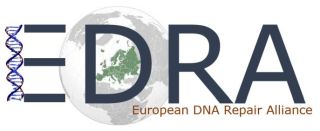|
|
|
Previous webinars > 9th webinar 09/19/20239th EDRA WebinarSeptember 19th, 2023, from 3:30 to 5:00 pm (CET)
Prof. Dr. Haico van Attikum - Keynote speaker Leiden University Medical Center (LUMC), Department of Human Genetics, Leiden, The Netherlands Specific killing of BRCA1-deficient cancer cells by depletion of EXO1 BRCA1 and BRCA2 are essential genome maintenance factors that function in the repair of DNA Double-Strand Breaks (DSBs) by homologous recombination (HR). Cancer patients that carry tumors with loss-of-function mutations in BRCA1 or BRCA2 often benefit from treatment with PARP inhibitor therapy, which specifically kills HR-deficient tumor cells. However, clinical responses are rarely long-lasting due to resistance to PARP inhibitor treatment. We therefore sought to identify novel therapeutic opportunities to treat HR-deficient tumors. Our studies revealed that genetic inactivation of the exonuclease EXO1 is severely toxic to BRCA1-deficient cells, but not to BRCA1-proficient cells. In my seminar I will present the mechanistic basis of this finding, highlighting EXO1 as a novel target with therapeutic potential for BRCA1-deficient tumors.
Amador Romero-Franco (PhD student) - Short talk University of Sevilla, CABIMER, Sevilla, Spain Human Cryptochrome I dampens homologous recombination at nightfall An exquisite regulatory network controls the choice between DNA double strand break repair mechanisms to maximize genomic integrity. Such regulation relies mostly at the level of DNA end resection, the initial steps of the homologous recombination repair pathway. In animals, most cellular and organismal activities follow a 24h oscillation known as the circadian cycle. Such repetitive changes are controlled by an intrinsic, molecular clock built-in at the cellular level which core components are the heterodimers BMAL1-CLOCK and CRY-PER. These inherent rhythms control many different aspects of the cellular metabolism, including the fate of many different DNA transactions. Here we have explored the regulation of different DNA double strand break repair pathways along the circadian cycle. We have found that DNA end resection shows a circadian oscillation, with a peak at dawn followed by a progressive reduction until dusk. Such regulation depends on the cellular levels of the circadian clock core component CRY1, as we have observed that upon the depletion of CRY1 both DNA end resection and Homology-directed Repair are increased upon double-strand break inducing treatments. Consequently, cells that lack CRY1 become hyperresistant to double-strand break inducing agents, meanwhile cells that overexpress this protein become hypersensitive. This further mirrors our observations from TGCA data, in which patients whose tumors express lower levels of CRY1 tend to survive less that those who express higher levels of CRY1. This modulation of double-strand repair outcome by the circadian clock is exerted at the CtIP-CCAR2 interface, not by the regulation of their protein levels, but by limiting CCAR2 anti-resection activity at nightfall
Dr. Vincent Gaggioli - Short talk Erasmus University Medical Center, Erasmus MC Cancer Institute, Rotterdam, The Netherlands Dynamic de novo heterochromatin assembly and disassembly at replication forks ensures fork stability Chromatin is dynamically reorganized when DNA replication forks are challenged. However, the process of epigenetic reorganization and its implication for fork stability is poorly understood. Here we discover a checkpoint-regulated cascade of chromatin signalling that activates the histone methyltransferase EHMT2/G9a to catalyse heterochromatin assembly at stressed replication forks. Using biochemical and single molecule chromatin fibre approaches, we show that G9a together with SUV39h1 induces chromatin compaction by accumulating the repressive modifications, H3K9me1/me2/me3, in the vicinity of stressed replication forks. This closed conformation is also favoured by the G9a-dependent exclusion of the H3K9-demethylase JMJD1A/KDM3A, which facilitates heterochromatin disassembly upon fork restart. Untimely heterochromatin disassembly from stressed forks by KDM3A enables PRIMPOL access, triggering single-stranded DNA gap formation and sensitizing cells towards chemotherapeutic drugs. These findings may help in explaining chemotherapy resistance and poor prognosis observed in patients with cancer displaying elevated levels of G9a/H3K9me3.
|



